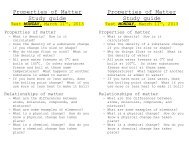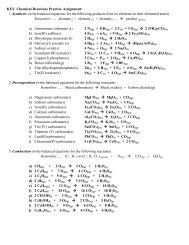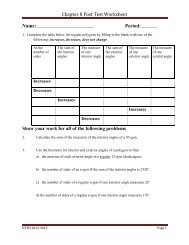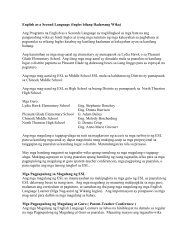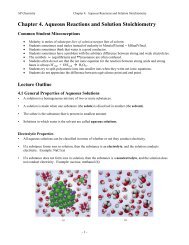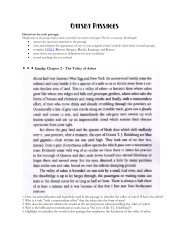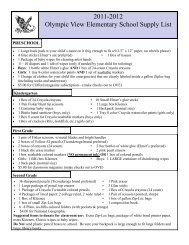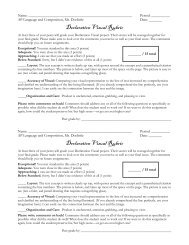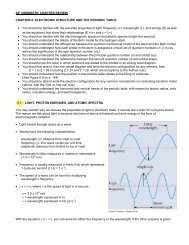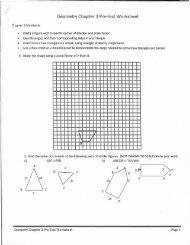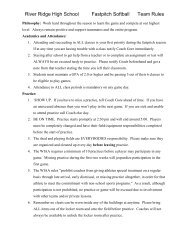WebQuest Packet.pdf
WebQuest Packet.pdf
WebQuest Packet.pdf
You also want an ePaper? Increase the reach of your titles
YUMPU automatically turns print PDFs into web optimized ePapers that Google loves.
Building Background KnowledgeTo Kill a Mockingbird<strong>WebQuest</strong>
IntroductionTo Kill a Mockingbird<strong>WebQuest</strong>You are about to read the novel, To Kill a Mockingbird by Harper Lee. The story is set inthe sleepy town of Maycomb, Alabama. Atticus Finch is asked to defend a black man chargedwith the rape of a white woman. Through the eyes of Atticus’s children, Scout and Jem,Mockingbird tells the story of adult attitudes toward race and class in the Deep South of the1930s. The consciousness of a town steeped in prejudice, violence, and hypocrisy is challengedby the quiet heroism of one man’s struggle for justice. To best understand the lessons of thisgreat novel, you must first understand the author, the times, and the place in which the story isset.TaskYour task for this <strong>WebQuest</strong> is to visit various websites (provided for you) to learnbackground information before starting the novel. To ensure that you are finding the importantmaterial at each site, you will also have a few questions to answer for each category. This<strong>WebQuest</strong> will give you a good feel for the 1930s and a good understanding of the historicalcontext of the story, so you will be better able to understand and enjoy the novel.The ProcessYou will work with a partner for this assignment. One of you should be in charge offinding the appropriate websites, while the other writes the answers. However, both of youshould observe the websites and both of you should provide input on the answers.ConclusionAfter completing this activity, you should have learned the following:· Background information about the author, Harper Lee· Historical background of the times· Insight into some of the events in the novel
To Kill a Mockingbird<strong>WebQuest</strong> QuestionsThis assessment is worth 75 PointsCategory #1 – Segregation – 19 points1. Where did the term, "Jim Crow," originate?2. After the year 1900, what did the term, "Jim Crow," become identified with?3. What Supreme Court case upheld segregation, or "separate but equal?"4. What was the name of the new literary movement, based in Harlem, New York, whichfeatured "New Negro" poetry and literature that emphasized self-respect and defiance underthe Jim Crow laws?6. How did some southern black people try to resist and escape the Jim Crow laws?7. Who were The Scottsboro Boys? What crime were they charged with?A. The Scottsboro Boys’ attorneys were extremely incompetent. How did thedefense attorneys show their lack of experience?B. Explain two of the inconsistencies in testimony by prosecution witnesses.C. Were the Scottsboro Boys ever pardoned of their wrongful convictions?8. Look at the different images portraying segregation. Select one that speaks to you and printit out. Write a brief description of the image and analyze why this image affects you. (This is amini-paragraph)Category #2 – The Great Depression - 14 points1. What is “Black Thursday”?2. How did the Wall Street Crash lead to The Great Depression?3. What percentage of the work force was unemployed during the worst part of theDepression?4. How were farmers and their families affected by the Depression?5. What did the “New Deal” do for the country?6. What were two of the programs created by the federal government to help out? Name themand explain what they provided.
7. Look at the different images from The Great Depression. Select one that speaks to you andprint it out. Write a brief description of the image and analyze why this image affects you. (Thisis a mini-paragraph)Category #3– Harper Lee – 12 points1. What connections are evident between Harper Lee’s life and the novel?2. When and where was Harper Lee born?3. What type of education did Harper Lee receive?4. What other famous writer was Harper Lee connected with? What did this other authorwrite? How is this person connected to TKAM?5. How has Harper Lee interacted with the media since the publication of TKAM?6. What awards and honors has Harper Lee received?Category #4 – Lifestyle of the 1930’s – 30 points1. Create a graphic organizer showing the similarities and differences between the life of ablack woman and a white woman growing up in the 1930’s South.2. Review the sites provided, paying attention to images, entertainment, and the lives ofpeople in the 1930’s. Create a character living in the 1930’s. Write a journal entry about aday-in-the-life of this person. It should include details about their social and economicstatus as well as their daily activities. Once you are finished with this journal entry, post iton the 1930’s Lifestyle Blog.
To Kill a MockingbirdWeb Quest – Analysis & Reflection1. What prior knowledge did you have about The Great Depression, Jim Crow laws, HarperLee and the Scottsboro Boys? Where did you acquire this knowledge?2. What new information did you gain from completing the Web Quest?3. Think about all the information you explored today. Which facts will you remember andthink about even after this unit is over? Why will you convert this information intoknowledge?5. Talk to an adult about the Web Quest you participated in today. Share your newunderstandings and ask them about their knowledge of any or all of our topics: The GreatDepression, Jim Crow laws, Harper Lee and the Scottsboro Boys. Write about the conversationyou had with an adult. You may want to discuss their reaction to your request for aconversation, their opinions and emotions concerning the topics, the sources of theirknowledge, and any new information they provided. If the adult you talk to is from anothercountry, ask if there were any similar events in their home country.
Works CitedAmerican Social History Project, Center for Media and Learning, and Roy Rosenzweig Center for Historyand New Media. “’Only Thing We Have to Fear Is Fear Itself’: FDR’s First Inaugural Address.”History Matters. City U of New York, George Mason U, 31 Mar. 2006. Web. 3 Aug. 2011..Anderson, Nancy. “Harper Lee.” Encyclopedia of Alabama. Auburn U, 23 June 2011. Web. 1 Aug. 2011..Banks, Ann. “The Great Depression and the New Deal.” Voices from the Thirties Home Page. Lib. ofCongress, 1980. Web. 1 Aug. 2011. .Barge, Peacolia. “Growing Up Black in the 1930s in McCulley’s Quarters Alabama.” Interview by ClaudiaDurt Johnson. ThinkQuest. Oracle Education Foundation, 1997. Web. 1 Aug. 2011..Bellafante, Ginia. “Harper Lee, Gregarious for a Day.” New York Times 30 Jan. 2006: n. pag. The New YorkTimes. Web. 1 Aug. 2011. .Cozzens, Lisa. “The Murder of Emmett Till.” Watson.org. N.p., 24 May 1998. Web. 3 Aug. 2011..Handschuh, Judith. “Author Profile: Harper Lee.” Teenreads.com. The Book Report Inc., 2003. Web. 3Aug. 2011. .“Harper Lee Writes Letter for Oprah.” Associated Press 20 Nov. 2009: n. pag. CBS News.com. Web. 1Aug. 2011. .Johnson, Claudia Durst. “Scottsboro Trial.” ThinkQuest. Oracle, 1994. Web. 1 Aug. 2011..
Kelly, Martin. “Top 5 Causes of the Great Depression.” About.com. New York Times Co., 2011. Web. 1Aug. 2011. .The Library of Congress. “America from the Great Depression to World War II Black and WhitePhotographs from the FSA-OWI 1935-1945.” American Memory. Lib. of Congress, 15 Dec. 1998.Web. 1 Aug. 2011. .Library of Congress. Black and White Photographs form the FSA-OWI 1935-1945 Alabama. AmericanMemory. Library of Congress, 13 Jan. 2011. Web. 3 Aug. 2011. .Library of Congress Researchers. “Photographs of Signs Enforcing Racial Discrimination: Documentationby Farm Security Administration-Office of War Information Photographs.” Prints andPhotographs Reading Room. Lib of Congress, 22 Oct. 2010. Web. 1 Aug. 2011..Linder, Douglas O. “The Trials of ‘The Scottsboro Boys.’” Famous Trials. U of Missouri Kansas City, 1999.Web. 1 Aug. 2011. .Mary Ann, Camille, Cecil. “Growing Up White in the South in the 1930s.” Interview by Claudia DurtJohnson. ThinkQuest. Oracle Education Foundation, 1997. Web. 1 Aug. 2011..Men & Women of the 1930s. “Federal Writers’ Project: Interview Excerpts.” Interview by FederalWriters’ Project. American Memory. Lib of Congress, 1980. Web. 1 Aug. 2011..National Museum of American History, Behring Center. “Separate Is Not Equal Brown V. Board ofEducation.” National Museum of American History. Smithsonian, 21 June 2011. Web. 1 Aug.2011. .
Nelson, Cary. “The Great Depression.” Modern American Poetry. Ed. Cary Nelson and BartholomewBrinkman. U of Illinois at Urbana Champaign, 1999-2011. Web. 1 Aug. 2011..Novkov, Julie. “Segregation (Jim Crow).” Encyclopedia of Alabama. Auburn U, 8 Mar. 2011. Web. 1 Aug.2011. .Pilgrim, David. “Who Was Jim Crow?” Jim Crow. Museum of Racist Memorabilia Ferris State U, Sept.2000. Web. 3 Aug. 2011. .“Roosevelt Facts and Figures.” Franklin D. Roosevelt Presidential Library and Museum. National Archives,n.d. Web. 3 Aug. 2011. .Rowen, Beth, and Borgna Brunner. “Great Days in Harlem The birth of the Harlem Renaissance.”infoplease. Pearson Education Inc., 2007. Web. 1 Aug. 2011. .“To Kill a Mockingbird About the Author.” The Big Read. National Endowment for the Arts, 2011. Web. 1Aug. 2011. .Wikipedia contributors. “Tom Swift.” Wikipeida. Wikipedia, The Free Encyclopedia, 6 June 2011. Web. 1Aug. 2011. .



